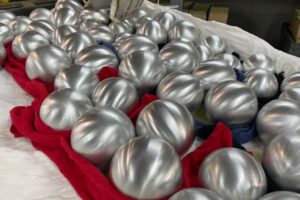



Chrome Plating, often referred to simply as chrome, is a technique of electroplating a thin layer of chromium onto a metal or plastic object. There are two main types of chrome plating used by industries today, hard chrome (industrial or engineered chrome) and decorative chrome (bright or show chrome). The chromed layer can provide protection of the base material, ease cleaning procedures, and increase the surface hardness or aesthetics.

Hard chrome plating is the process of depositing a thick layer of chromium metal onto metallic components for the benefits of reduced friction, improved durability through abrasion tolerance and wear resistance in general, minimizing galling or seizing of parts, and bulking material for worn parts to restore their original dimensions. It is very hard, measuring between 65 to 69 HRC. Hard chrome tends to be thicker than decorative chrome, with standard thicknesses in non-salvage applications ranging from 0.0002 to 0.020 inch. Unfortunately, greater thicknesses emphasize the limitations of the process, which are overcome by plating extra thickness then grinding down and lapping to meet requirements or to improve the overall aesthetics of the “chromed” piece. Increasing plating thickness amplifies surface defects and roughness in proportional severity because hard chrome does not have a leveling effect.
This type of chrome is the process of depositing a very thin layer (sometimes as thin as 50 millionth of an inch) of chromium over nickel-plated components resulting in a bright, shiny finish. The function of a thin chrome layer is twofold; it protects the nickel from oxidizing or tarnishing and provides wear resistance, preventing surface scratches. The nickel under layer keeps its intended finish longer by providing corrosion protection to the base material. In some applications, copper plating is used as the under layer to improve the strength of the base material.
Both of these finishes are applied in the exact same way, by submerging a part into an electrolyte bath of chromic acid and then passing an electrical current through it. No matter the size or shape of the part, chrome will plate evenly onto the surface. This includes cylindrical parts and parts with uneven surfaces, holes, and recesses. Chrome conforms to many components, making it one of the most used options for surface finishes. Both are easy to clean due to their corrosion and wear resistant properties.
Despite having similar electroplating processes, the form and function of these two plating options make them very different. What you use on your parts will ultimately depend on the environments that they will be in.
We’re confident US Chrome will be your best option for your chrome plating applications because of our engineering approach, exceptional customer service, and regional locations. Contact us now with your questions or coating challenges.
We’ll help you find the right answer.
Subscribe to our newsletter to learn more about the electroplating industry!
US Chrome has been helping engineers find solutions to surface coating challenges for more than 80 years.